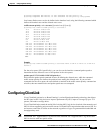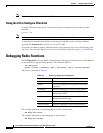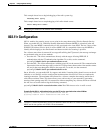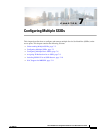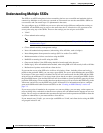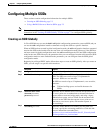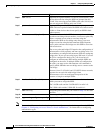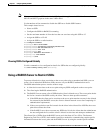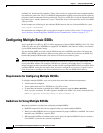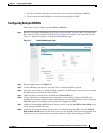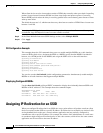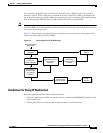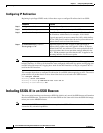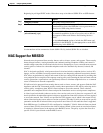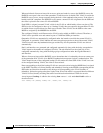
7-5
Cisco IOS Software Configuration Guide for Cisco Aironet Access Points
OL-30644-01
Chapter 7 Configuring Multiple SSIDs
Configuring Multiple SSIDs
Note When you enable guest SSID mode for the 802.11g radio it applies to the 802.11b radio as well since
802.11b and 802.11g operate in the same 2.4Ghz band.
Use the no form of the command to disable the SSID or to disable SSID features.
This example shows how to:
• Name an SSID
• Configure the SSID for RADIUS accounting
• Set the maximum number of client devices that can associate using this SSID to 15
• Assign the SSID to a VLAN
• Assign the SSID to a radio interface
AP# configure terminal
AP(config)# dot11 ssid batman
AP(config-ssid)# accounting accounting-method-list
AP(config-ssid)# max-associations 15
AP(config-ssid)# vlan 3762
AP(config-ssid)# exit
AP(config)# interface dot11radio 0
AP(config-if)# ssid batman
AP(config-if)#end
Viewing SSIDs Configured Globally
Use this command to view configuration details for SSIDs that are configured globally:
AP# show running-config ssid ssid-string
Using a RADIUS Server to Restrict SSIDs
To prevent client devices from associating to the access point using an unauthorized SSID, you can
create a list of authorized SSIDs that clients must use on your RADIUS authentication server.
The SSID authorization process consists of these steps:
1. A client device associates to the access point using any SSID configured on the access point.
2. The client begins RADIUS authentication.
3. The RADIUS server returns a list of SSIDs that the client is allowed to use. The access point checks
the list for a match of the SSID used by the client. There are three possible outcomes:
a. If the SSID that the client used to associate to the access point matches an entry in the allowed
list returned by the RADIUS server, the client is allowed network access after completing all
authentication requirements.
b. If the access point does not find a match for the client in the allowed list of SSIDs, the access
point disassociates the client.
c. If the RADIUS server does not return any SSIDs (no list) for the client, then the administrator
has not configured the list, and the client is allowed to associate and attempt to authenticate.
The allowed list of SSIDs from the RADIUS server are in the form of Cisco VSAs. The Internet
Engineering Task Force (IETF) draft standard specifies a method for communicating vendor-specific
information between the access point and the RADIUS server by using the vendor-specific attribute



